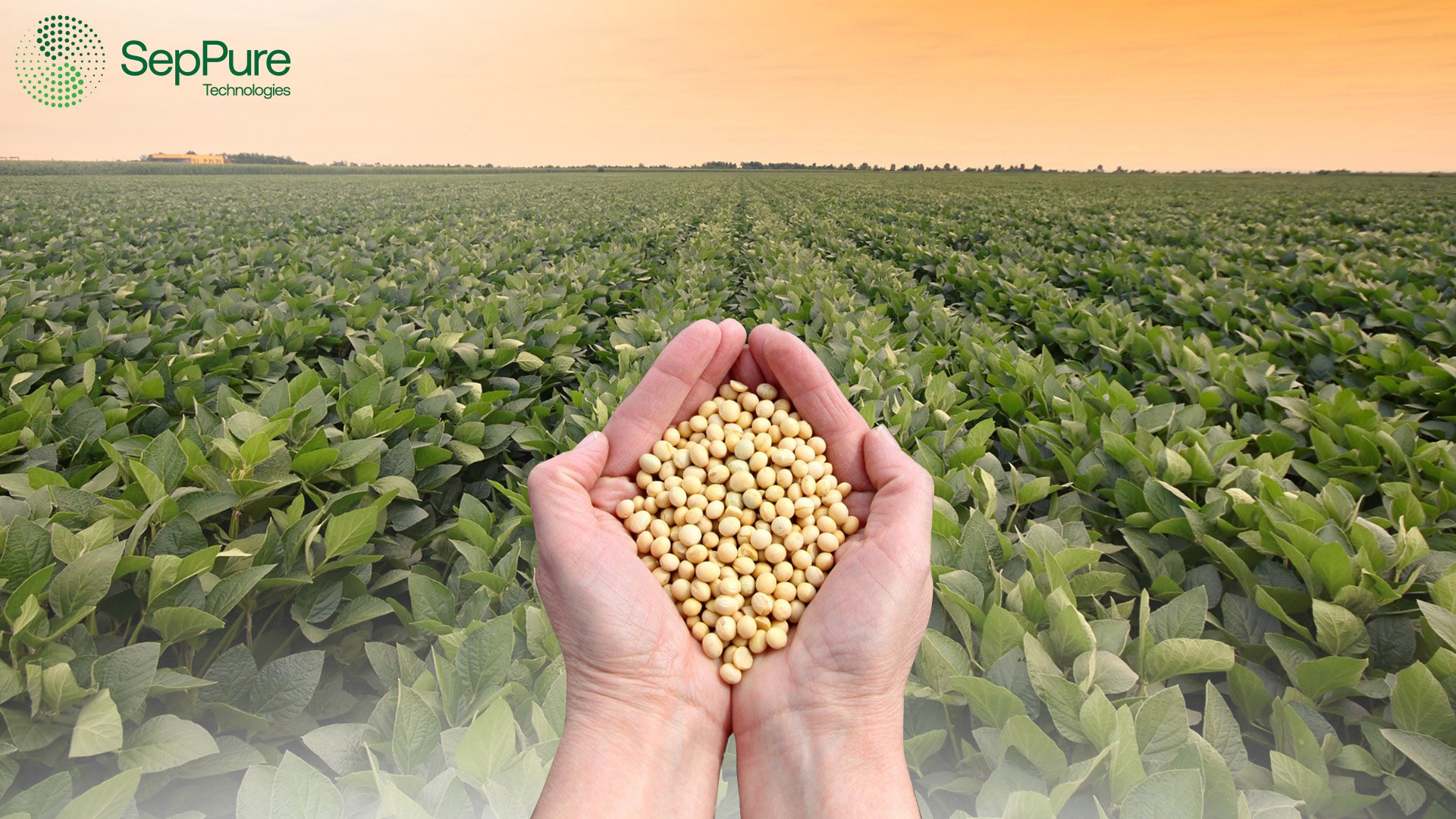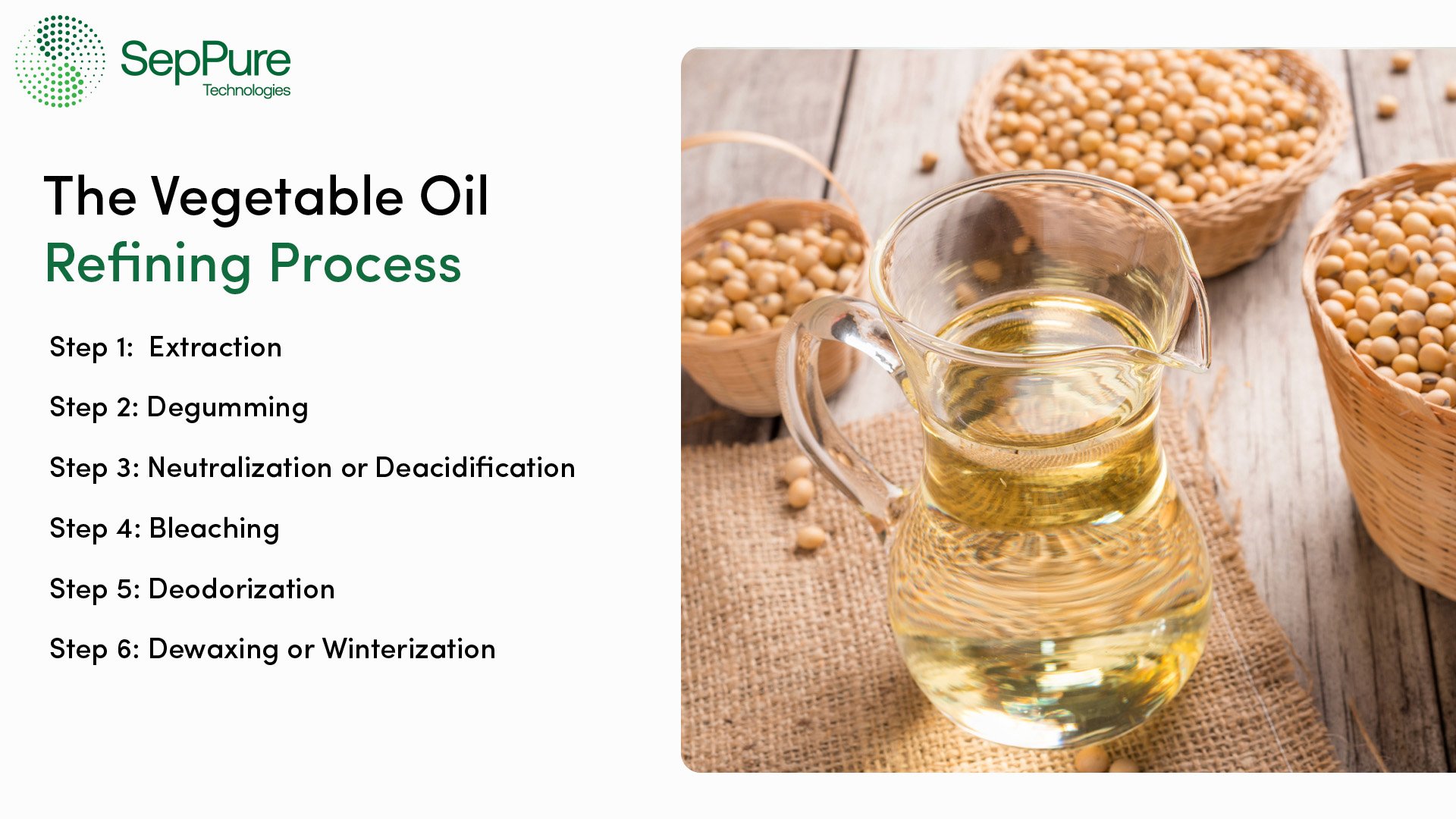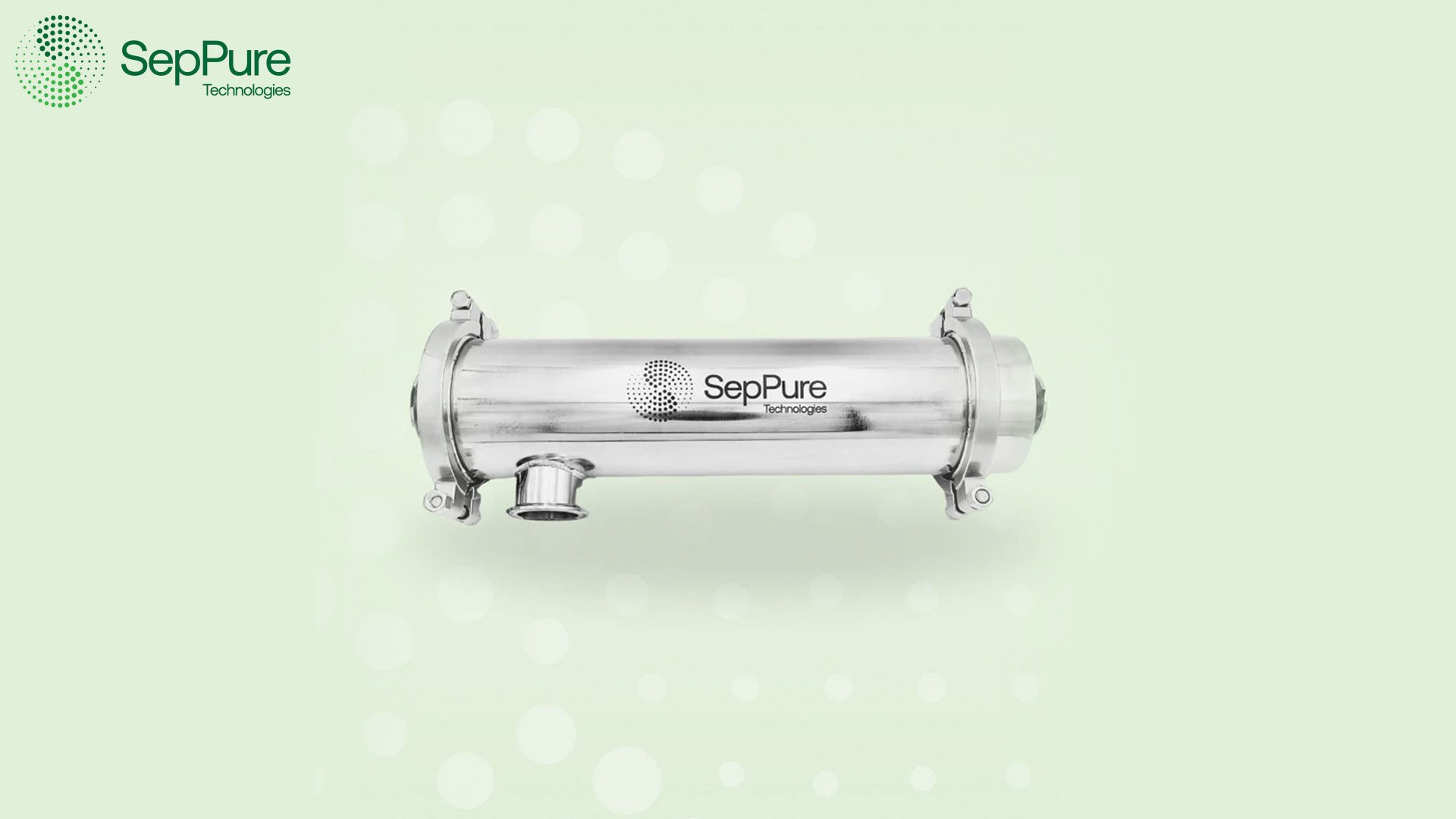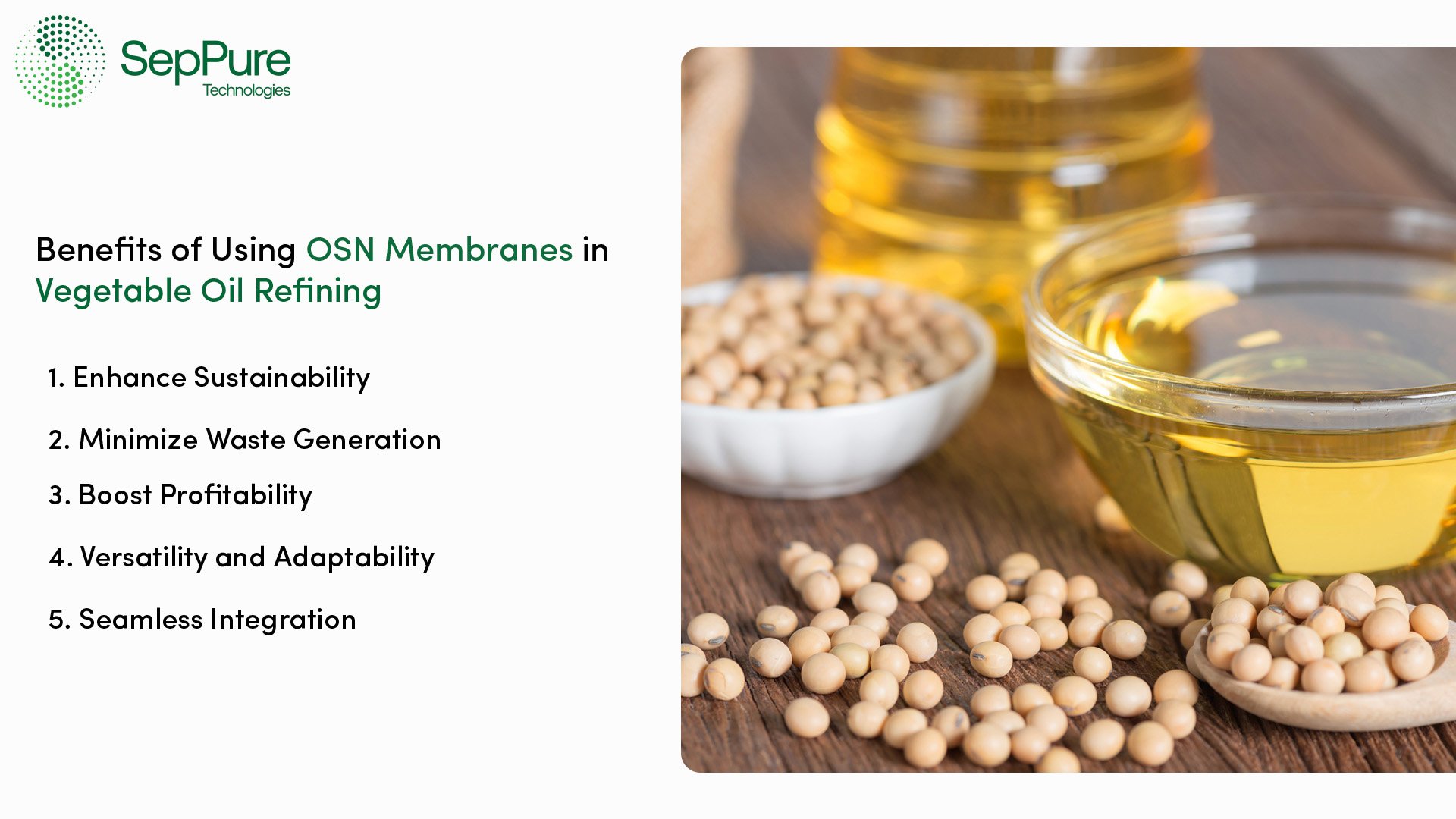Pioneering Sustainability: Integrating Nanofiltration Technology into Vegetable Oil Refining Processes
The global demand for vegetable oil continues to rise, with the latest USDA outlook estimating global production at 228.3 million tonnes in 2024/25, reflecting an increase of 4.5 million tonnes compared to 2023. Nevertheless, this growing demand underscores pressing environmental, economic, and operational challenges, as the current refining methods in the industry are energy-intensive, generating high costs, substantial greenhouse gas (GHG) emissions, and significant waste.
Organic Solvent Nanofiltration (OSN) membrane technology offers a promising solution to some of the challenges within this sector. Continue reading as we explore the process of vegetable oil refining and how nanofiltration technology can drive more efficient and sustainable industrial practices.
Understanding the Vegetable Oil Refining Process
How Is Vegetable Oil Refined?
Refined vegetable oil is oil extracted from plant sources that has been purified to remove impurities and contaminants. This results in a clear, neutral-tasting product suitable for various culinary and industrial applications.
There are a number of steps involved in the conventional vegetable oil refining process:
Step 1: Extraction
The process begins with extracting the oil from the oilseed. In a milling facility, the oilseed undergoes several preprocessing steps, including sorting, washing, and digesting. The seeds are then fed into a crushing unit—usually a mechanical press—which expels most of the oil from the seed. However, as much as 18% of valuable oil remains trapped in the solid matrix and cannot be removed by mechanical methods alone.
For commodity oils such as soybean, canola, and palm, every last drop of oil is precious. The crushed seeds are sent to a solvent extraction plant, where solvents are added to dissolve the remaining oil. This creates a mixture called miscella, which is subjected to a series of heating processes before being processed in a distillation unit. Here, the heat is applied to vaporize the solvent, leaving behind pure oil. The solvent vapor is subsequently cooled and collected in a tank to be reused for extraction.
Step 2: Degumming
Degumming is a vital step in vegetable oil refining. It removes “gums” or mucilage, which are primarily made of phospholipids, along with other substances, such as carbohydrates, proteins, and trace metals. Phospholipids are naturally found in oils and are important biochemical intermediates in the growth and function of plant cells. However, they can also create storage and processing issues, as they are often associated with heavy metals that promote oxidation, and in some cases, act as prooxidants. Failing to remove phosphorus-rich components can lead to further refining challenges and darkening of the oil during storage. Thus, the phospholipids are eliminated in this stage by washing the oil with water, which precipitates the gums, creating a mixture that is separated by decanting or centrifugation.
Step 3: Neutralization or Deacidification
Free fatty acids present in crude vegetable oil can impart undesirable flavors and reduce shelf life. An alkali, usually sodium hydroxide (caustic soda, sometimes also referred to as Lye), is added to neutralize and remove these free fatty acids from the oil. This process is known as chemical deacidification. At the same time, this produces soapstock—a dense mixture of soap, fatty acids, and water—that is later separated from the oil through centrifugation.
However, chemical deacidification has several significant disadvantages that impact both the efficiency and environmental footprint of the process.
Firstly, yield loss is a major concern. The chemical deacidification process produces soapstock, a dense mixture of soap, fatty acids, and water, resulting in a substantial loss of neutral oil. Specifically, for every kilogram of soap stock produced, approximately one kilogram of neutral oil is lost. This directly reduces the overall yield of the oil refining process, leading to inefficiencies and increased raw material costs.
Secondly, the process generates wastewater, which poses environmental and operational challenges. The wastewater produced contains residual caustic soda, soap stock, and other impurities that need to be treated before disposal. The treatment of this wastewater incurs additional costs for the oil refinery, including the installation and maintenance of wastewater treatment facilities. Furthermore, managing this wastewater can be environmentally burdensome; improper treatment or disposal could lead to pollution and further complicate the sustainability of the operation.
Overall, while chemical deacidification is effective in neutralizing free fatty acids, the associated yield loss and wastewater generation make it a less favorable option, especially in contexts where maximizing yield and minimizing environmental impact are critical objectives.
Step 4: Bleaching
The next step is bleaching, aimed at removing pigments, peroxides, and residual fatty acids and salts. This is achieved using adsorption agents such as bleaching clays, activated carbon, or special silica.
Step 5: Deodorization
During deodorization, the oil is heated at high temperatures to remove odors, off-flavor components, and other contaminants. Volatile compounds are eliminated through steam distillation, where water vapor is passed through the oil to carry away these unwanted substances.
Step 6: Dewaxing or Winterization
The final step of the vegetable oil refining process is known as dewaxing or winterization. This is applied when the oil product appears cloudy or hazy at room temperature—a problem often encountered in colder climates. This step is especially crucial for oils like palm, sunflower, and soybean and involves cooling the oil to crystallize waxes that are then filtered to keep the oil clear and stable.
Industrial Applications of Vegetable Oil
Having explored the detailed steps involved in vegetable oil refining, it is crucial to understand the diverse everyday and industrial applications of the refined product.
Cooking Oil and Food Processing
Refined vegetable oils, including those from palm, soybean, canola, and others, are integral to the food industry. They are widely incorporated into a variety of food products, such as baked goods, snacks, margarine, salad dressings, and sauces, as their neutral flavor ensures that the taste of the end product remains unaffected. Additionally, these oils have a high smoke point, which allows them to endure the high temperatures used in cooking and processing without breaking down.
Biofuel Production
Refined vegetable oils are also a significant source of biodiesel, with over 80% of biodiesel produced from oils such as palm, soybean, and canola. Biodiesel derived from vegetable oils serves as a renewable alternative to conventional diesel, reducing reliance on fossil fuels and lowering overall GHG emissions.
Cosmetics and Personal Care Products
Certain refined vegetable oils, such as olive, coconut, and avocado oil, have emerged as a more natural and sustainable alternative to mineral oil in the cosmetics industry. Their emollient and moisturizing properties make them ideal ingredients for a wide variety of products, ranging from creams and serums to hair treatments and gentle cleansers.
Industrial Lubricants
With their viscosity and cooling properties, soybean and rapeseed oils are employed as base oils in industrial lubricants, such as hydraulic fluids, metalworking fluids, and compressor oils. However, these refined vegetable oils often require chemical modification to enhance their oxidative stability and meet the demands of specific lubrication applications.
Pharmaceuticals
The purity and stability of refined vegetable oils make them essential for ensuring the safety and efficacy of pharmaceutical products. Soybean and sesame oils, for example, serve as excipients in injectable formulations and provide a stable medium for drug delivery. Additionally, refined olive oil is used as an active pharmaceutical ingredient (API) in the formulation of poorly soluble drugs, injectables, and syrups. Overall, their refined nature makes these oils crucial for maintaining the integrity of medications and meeting strict sterility standards in the industry.
Environmental Challenges in Vegetable Oil Refining
Despite their extensive use and critical role across various industries, the current vegetable oil refining process faces significant environmental, economic, and operational challenges.
1. Energy Consumption
Vegetable oil refining is a highly energy-intensive process. The refining process, as explained above, requires multiple stages including degumming, neutralization, bleaching, deodorization, and more, each of which requires substantial amounts of energy. This demand often relies on the burning of fossil fuels, contributing to substantial greenhouse gas emissions and depleting non-renewable resources. The energy consumption associated with the processing of vegetable oil not only impacts operational costs but also highlights the need for more sustainable energy solutions.
2. Water Usage, Wastewater Generation, and Pollution
Vegetable oil refining requires vast amounts of water for steam generation, equipment cleaning, product cooling, and more. This large-scale water use strains local water resources, particularly in regions facing water scarcity. In addition, the refining process also generates substantial amounts of wastewater, which can contain a variety of pollutants, including fatty acids, phospholipids, and residual chemicals from the refining process. Improper treatment of wastewater can lead to severe environmental impacts, including water pollution, affecting aquatic ecosystems, and even public health.
3. Chemical Usage and Waste Generation
Various chemicals, such as caustic soda and bleaching agents, are employed throughout the refining process to remove impurities, color, and odors from the oil. However, improper handling, storage, and disposal of these chemicals can contribute to air and soil pollution as well as contaminate water resources.
Organic Solvent Nanofiltration (OSN) Membranes; A Sustainable Alternative
In order to address the challenges highlighted, an urgent shift and transition toward more sustainable alternatives is needed. This is where organic solvent nanofiltration (OSN) membranes come into play, offering a promising solution for improving the efficiency and sustainability of the vegetable oil refining process.
What Are Organic Solvent Nanofiltration (OSN) Membranes and How Do They Work?
OSN membranes are specialized filtration systems, specifically designed and engineered to handle liquid streams containing organic solvents. Unlike conventional filtration systems, which are typically limited to water-based solutions, these membranes are designed to endure a wide range of solvents. This makes this type of filtration suitable for diverse industrial applications, such as vegetable oil refining, pharmaceutical, semiconductors, and many more.
As for their construction, OSN membranes are made of solvent-resistant polymeric materials. These membranes feature pores ranging from less than 1 nanometer, acting as selective barriers that filter out molecules based on size, charge, and molecular weight.
Learn more: A Comprehensive Guide to Nanofiltration Membranes
Integrating Nanofiltration Technology in Vegetable Oil Refining
With these advanced nanofiltration membrane technologies, the vegetable oil refining industry is now positioned to enhance processes and adopt a more innovative approach to refining. Here are some ways in which OSN membranes can be integrated into the vegetable oil refining process:
1. Solvent Extraction
Solvents are used during the initial solvent extraction process to extract residual oil from crushed oilseeds. Traditionally, distillation is then employed to separate the resulting miscella, yielding pure solvent and vegetable oil, which is a highly energy-intensive process.
However, nanofiltration membranes provide a more efficient alternative. These membranes allow the solvent to selectively pass through while retaining the oil components, resulting in a more precise separation. Our DE(SOLV)® system enables energy-efficient separation and removes 90% of solvents without the use of heat.
Green solvents can also be used during the extraction process to further enhance sustainability. Although solvents like hexane are typically used for their easy oil recovery, narrow boiling point, and excellent solubility, they pose significant health and environmental risks. Instead, green solvents like methyloxolane can be used alongside nanofiltration membranes for a safer and more eco-friendly alternative.
2. Deacidification Process
Nanofiltration technology can be utilized to remove free fatty acids, wax and lipids, hydrocarbons, and soapstock from oil during the deacidification process. OSN membranes can be engineered to selectively retain particular molecules and larger impurities while allowing neutralized oil and smaller molecules to pass through. This improves the efficiency of FFA removal, reducing the need for harsh chemicals without compromising oil quality.
3. Solvent Fractionation
Solvent fractionation is an essential process for tailoring the melting characteristics of triglyceride oils to meet specific application requirements and improve product stability. Integrating nanofiltration technology into edible oil refining can optimize this process by enhancing the precise separation of components, such as olein and stearin, from solvents like acetone. This results in higher purity fractions, improving the overall quality of the end product and optimizing the entire operation.
Benefits of Using OSN Membranes in Vegetable Oil Refining
Integrating OSN membranes into the vegetable oil refining process brings several notable advantages.
1. Enhance Sustainability
Using OSN membranes in the vegetable oil refining process significantly contributes to sustainability. They operate effectively without the need for energy-intensive distillation processes. By offering a sustainable alternative that changes the driving force from thermal to mechanical, OSN membranes have the potential to significantly reduce energy consumption. For instance, SepPure Technologies’ advanced OSN membrane technology, GreenMem® cuts emissions by 90%, making the process sustainable.
2. Minimize Waste Generation
In addition to its substantial energy consumption, distillation requires water-intensive washing and cooling steps to condense and recover pure solvents. By substituting these processes with membrane technology, the vegetable oil processing industries can mitigate the amount of wastewater generated, alleviating the burden on waste treatment facilities.
Furthermore, the efficiency of OSN membranes diminishes the need for chemical additives and professional aids to refine the oil. This enables simpler, cleaner processes with fewer byproducts and contaminants, thereby lowering the overall environmental impact and improving safety in handling and disposal.
3. Boost Profitability
By making the transition to OSN membranes, businesses lessen their dependence on costly fossil fuels. This shift helps stabilize operating costs by reducing the need for frequent fuel purchases and insulating businesses from the volatility of fuel markets. This allows producers to better manage their budgets and avoid sudden spikes in energy costs, leading to more predictable financial planning and potentially higher profit margins. Given the narrow profit margins in the vegetable oil industry, reducing reliance on fossil fuels presents a considerable economic advantage.
4. Versatility and Adaptability
OSN membranes provide exceptional flexibility and adaptability, making them suitable for a wide range of vegetable oils and diverse refining conditions. Their design can be customized to target specific impurities, enabling a highly tailored approach to the refining process. This ensures that the refining process can be adjusted to meet various quality standards and market demands.
5. Seamless Integration
Finally, the modularity of OSN membranes enables their seamless integration into existing refining processes. This means that refineries can enhance their operations without necessitating major overhauls of their current infrastructure. Additionally, their modular nature also means that they can be implemented incrementally, allowing refineries to gradually adapt to new processes while maintaining their production schedules.
Pioneering Sustainability with SepPure Technologies
As global awareness of environmental degradation from industrial activities grows, the push for sustainable practices becomes increasingly critical. Integrating nanofiltration membranes into vegetable oil refining processes addresses some of these challenges by offering a solution that significantly reduces chemical use and waste while enhancing resource efficiency.
For cutting-edge nanofiltration solutions optimized to your specific industrial needs, consider SepPure Technologies. We specialize in engineering chemical-resistant hollow fiber OSN membranes, designed to deliver superior performance and precision while also supporting sustainability goals.
Reach out to us and transform your operations with our technology today.
Frequently Asked Questions About Nanofiltration Membranes
-
Due to their high adaptability, OSN membranes find widespread applications in various industries, including food and beverage, pharmaceutical, petrochemical, biodiesel, semiconductors, specialty chemicals, and more. For instance, in the vegetable oil refining industry, they can be utilized for desolvation of oil and solvent miscella, solvent extraction processes, solvent fractionation, free fatty acid (FFA) removal, wax, and lipid removal, and more. In the pharmaceutical industry, they can be used for API concentration, solvent exchange, homogenous catalyst recovery, and other API and spent solvent purification amongst their other uses, and more.
-
Traditional separation methods in the vegetable oil refining industry rely significantly on energy-intensive processes such as distillation and evaporation. In contrast, OSN membranes offer a more sustainable approach, as they require less energy and water consumption, produce less waste, and enable higher yields. This not only enhances operations but also reduces the environmental footprint of oil refining operations.
-
Implementing OSN membrane technology can yield long-term savings by displacing heat from the process, reducing chemical use, minimizing waste, and enhancing overall efficiency. According to the United States Department of Energy, organic solvent nanofiltration (OSN) process technology has the potential to save $4 billion in annual energy costs in the U.S. alone, making it a far more cost-effective process compared to current methods.






